One of the most important decisions you have to make when bringing home a new indoor plant is placement. Providing the correct amount of sunlight for each different type of houseplant is crucial in its ability to thrive.
Rooms with north-facing windows provide the least amount of exposure to direct sunlight, meaning only certain types plants will be able to survive there. Luckily, there are lots of options to choose from for plants who prefer indirect light.
As an added bonus, many of the plants on this list are extremely hardy and easy to care for. Plants who thrive in low light conditions are often slow-growers. This makes them more tolerable to moderate amounts of neglect (whether it be accidental, or on purpose.)
This list will provide you with twenty excellent north-facing window plant choices who can survive in low light conditions.
Keep in mind that all plants need at least some light to survive and no plant likes to be placed in a random dark corner. You should still try to place any of these low light plants within at least a foot of the north-facing window.
Here are 20 great north-facing window plants that will do well even if your window doesn’t get bright sunlight.
1. Golden Pothos (Epipremnum Aureum)
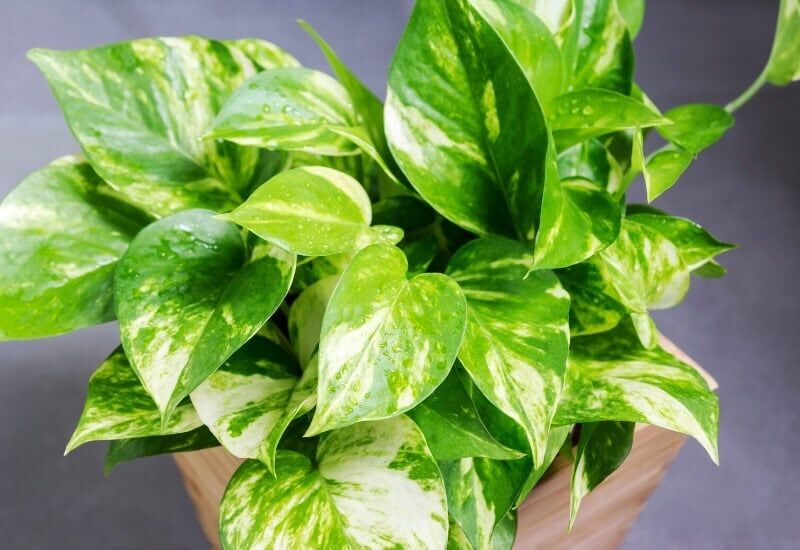
Pothos plants, often mistaken for Philodendrons, make an excellent choice for low-light environments because they are incredibly hardy and versatile.
They can thrive in all conditions from shady low-light areas, to bright direct light. Whether potted in just a bowl of water, or dry sandy soil your Pothos will keep on growing.
Pothos prefer the warmth and high humidity, but will tolerate almost any conditions inside the home. Growing as a vine, pruning is important to keep them from overgrowing the container.
As an added bonus, it is very simple to propagate new Pothos plants from the pruned shoots. Just place the pruned shoot in a cup of water, where it will grow new roots and be ready for soil in just a few weeks.
Light: Can thrive in nearly any light conditions.
Water: Water regularly, allowing the soil to dry between waterings.
Description: Grows as a vine and can become quite long. Prune regularly and propagate cuttings in a cup of water.
2. Heart-Leaf Philodendron (Philodendron Scandens)
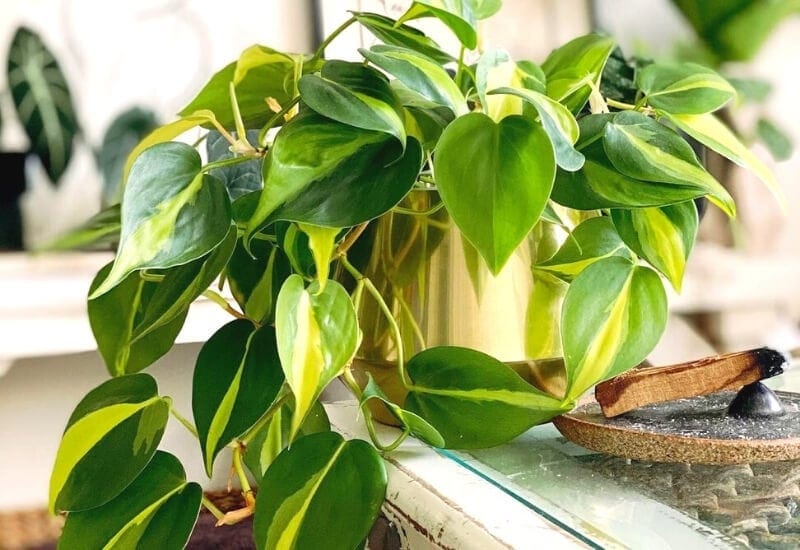
The main difference between Pothos and Philodendron plants is the color of their leaves. While pathos have large dark green leaves with yellow or white variegation, philodendron plants have smooth, heart-shaped leaves with a solid green color.
Like the Pothos, Philodendron plants don’t require very much maintenance. These plants prefer indirect sunlight and will burn easily when exposed to direct rays. This makes them perfect plants for a north-facing window.
The Philodendron is also a vine that can be trained along a trellis or using thumbtacks to prop the vines around a window. Along with avoiding direct sunlight, it’s also important to avoid overwatering the Philodendron.
Water: Use well-draining soil and allow soil to dry before watering. Be careful to avoid overwatering.
Light: Sensitive to direct sunlight. A north-facing window is best.
Description: Grows as a vine which can be trained along a trellis.
3. Swiss Cheese Plant (Monstera Deliciosa)
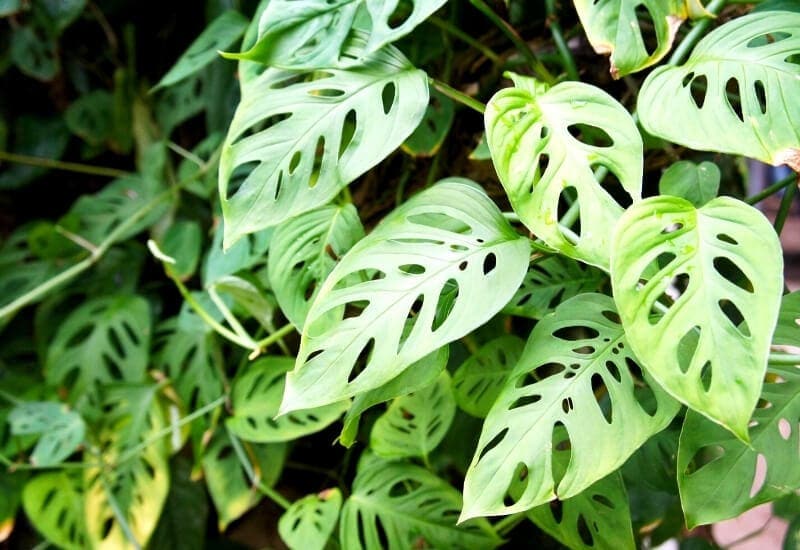
Famous for the iconic foliage, Monstera plants provide a dramatic and eye-catching addition to a low-light space. They prefer bright, indirect light but can tolerate lower-light conditions if placed near a north-facing window.
Known for the holes and slits in their leaves resembling Swiss cheese, these markings won’t appear until the plant is mature enough.
Until then, the leaves will be small and heart-shaped. If provided with a trellis to climb, these plants can grow to be quite tall.
Since the Monstera is a tropical plant, it prefers nutrient rich and well-draining soil. Water often, but always allow the top two-inches to dry between waterings.
Fertilizing monthly during the growth period with a high nitrogen fertilizer will encourage strong healthy leaf growth.
Water: Rich well-draining soil is best. Water regularly and fertilize monthly.
Light: Prefers bright, indirect light. Place as close as possible to a north-facing window.
Description: Will grow to be quite large with huge leaves covered in holes. Can also be trained with a trellis to grow very tall.
4. Spider Plant (Chlorophytum Comosum)
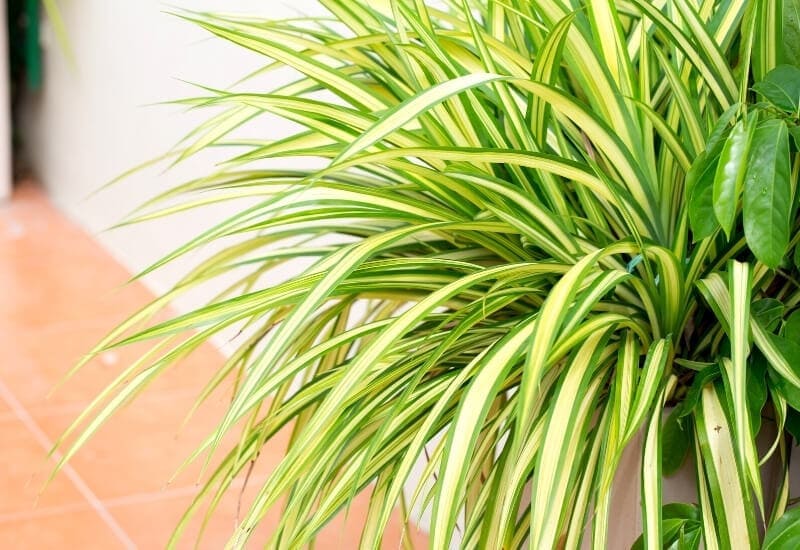
Spider plants are incredibly easy to care for, tolerating nearly any conditions inside the home. They can happily live in very low amounts of light and thrive in north-facing windows.
Although able to survive in periods of drought, Spider Plants do best with consistent watering. They would also prefer a little extra humidity to protect against browning leaf tips, especially if you live in a dry environment.
As your spider plant matures, the leaves will become more dramatic in length and color. Eventually, it will even start to shoot out spiderettes which will have flowers.
If these flowers are not pollinated, they will grow into tiny plantlets which can be cut and placed in a cup of water to propagate.
Water: Tolerant to drought, but thrive with consistent watering.
Light: Very hardy plant who ishappy to live in low-light environments.
Description: Prefers higher humidity to avoid browning leaf tips. Can produce spiderettes for propagation.
5. English Ivy (Hedra Helix)
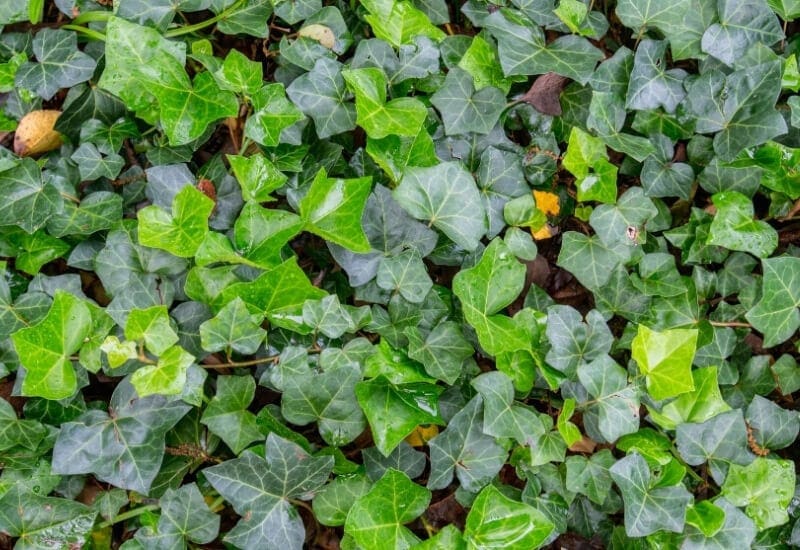
In the wild, English ivy is often considered a pest, or weed, because of their ability to spread and consume areas. These are very hardy plants who do great in low-light environments.
English ivy grows as a vine which will need a trellis or support structure to climb. They can also do very well as a hanging plant. Their unique leaves make them a lovely and elegant looking choice for a north-facing window.
Although English ivy is considered a hardy plant, they can dry out easily and prefer higher humidity environments. Surprisingly they also prefer colder conditions, ideally around 60-65 degrees.
Water: Dries out easily, keep soil moist.
Light: Thrives in shady and cool environments.
Description: Prefers a humid environment. Grows as a vine making an excellent hanging or trellised plant.
6. Lucky Bamboo (Dracaena Sanderiana)
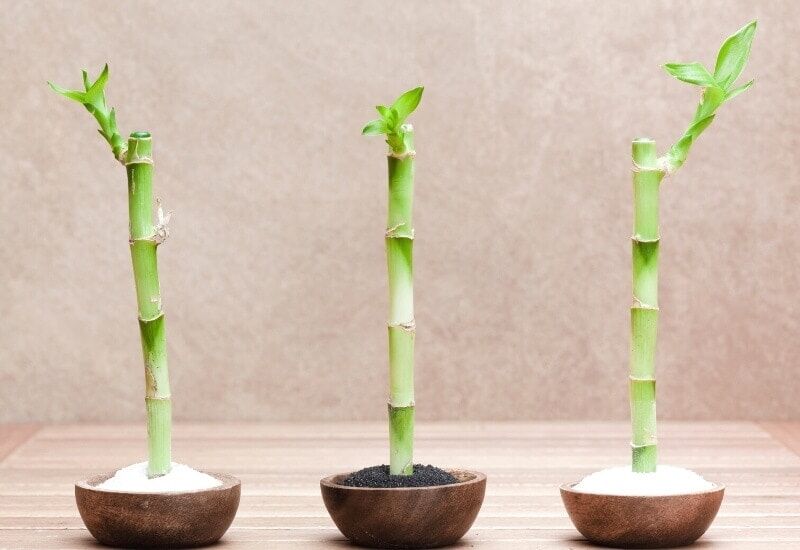
Lucky bamboo does best in bright, indirect light. his makes them a good option for placement right in a north-facing window.
These beautiful and hardy plants can be grown in soil, or even just water with some rocks. They are also conveniently resistant to pests which might harm your other houseplants.
Commonly found in many different shapes and sizes, these plants are flexible and can be shaped as they grow. This is why you will see Lucky bamboo plants often arranged in novel and decorative displays.
Water: Can be grown in water or soil. If grown in soil, water regularly.
Light: Sensitive to direct light. Prefers filtered or indirect light to avoid leaf scorching.
Description: Flexible and easy to train, usually sold in novel decorative displays.
7. ZZ Plant (Zamioculcas Zamiifolia)
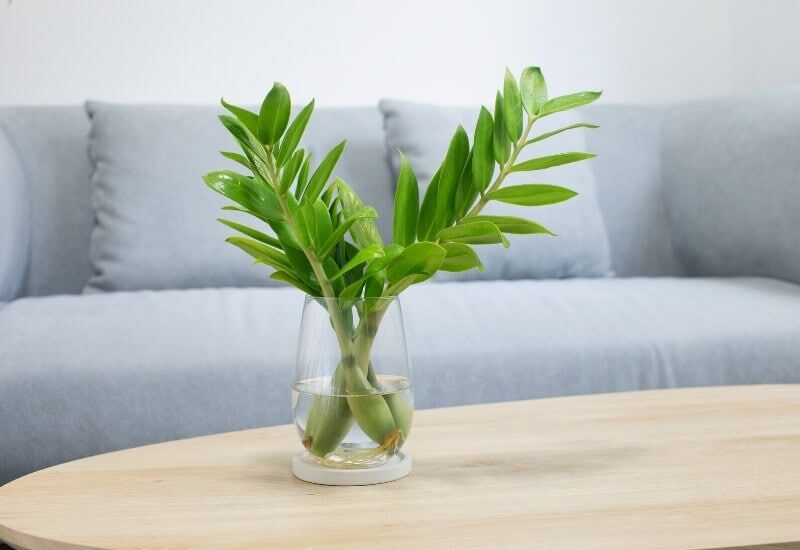
Although not immediately related to the succulent family, the ZZ plant can be treated like one. They prefer sandy soil, like a succulent mix, and less water than most other houseplants.
These plants grow exceptionally well in low-light conditions, even able to survive in rooms without windows. However, the ZZ plant grows very slowly, but eventually can reach up to three feet in height.
They are also incredibly versatile, thriving in a wide range of temperatures and humidity levels. The ZZ plant can even recover quite quickly after accidental neglect. However even with their resilience, it is important not to overwater the ZZ plant.
Beware of this plants toxicity to pets. They can even cause irritation to the skin if handled while pruning.
Water: Water sparingly, about once per month like a succulent.
Light: Exceptionally capable of growing in environments with little to no direct light.
Description: Prefers average temperatures and humidity. Prune occasionally. Toxic to pets.
8. Prayer Plant (Ctenanthe)
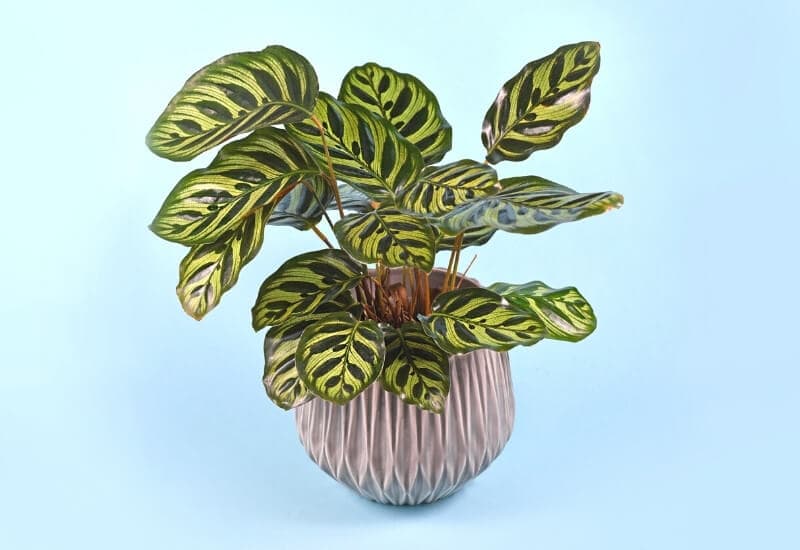
The prayer plant, also known as the Never-never plant, is an absolutely beautiful tropical houseplant which grows low to the ground with large gorgeous leaves.
These leaves are usually light green with dark green markings, accented with red or purple lines and undersides, and often have deep purple stems.
These hardy and resilient plants thrive in warm and humid environments where they will receive bright, indirect light. This makes them a great addition to a north-facing windowsill.
Try to keep the soil moist and supplement humidity with a spray bottle or cup of water placed on top of a radiator near by. These plants are known to be toxic to pets.
Water: Water frequently, keeping the soil moist.
Light: Prefers bright, indirect light. Perfect for north-facing windowsill.
Description: Requires higher humidity to thrive. Toxic to pets.
9. Aluminum Plant (Pilea Cadierei)
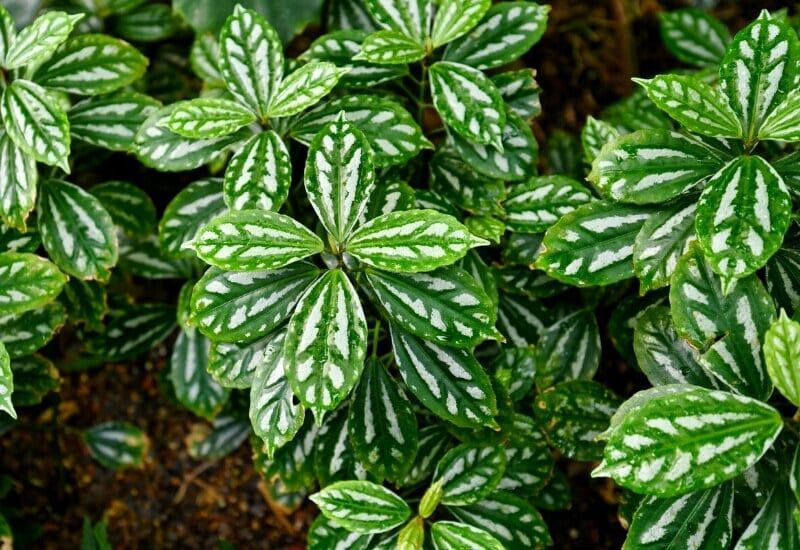
Known for the bright silver markings across its lime green leaves, the Aluminum plant is a very beautiful tropical houseplant. Native to tropical forest floors, these plants thrive in warm and humid conditions with indirect or filtered light.
The Aluminum plant requires constant pruning to keep at a desired size and shape, due to their fast growth and constant spread outwards. It is common practice to pinch off any flower that might appear, which will encourage the growth of more foliage.
Water these plants often, but allow the soil to dry between waterings to avoid root rot.
Water: Water regularly, allowing the soil to dry between waterings.
Light: Thrive in indirect or low-light environments.
Description: Requires higher humidity environment and frequent pruning.
10. Sword Fern (Nephrolepis Exaltata)
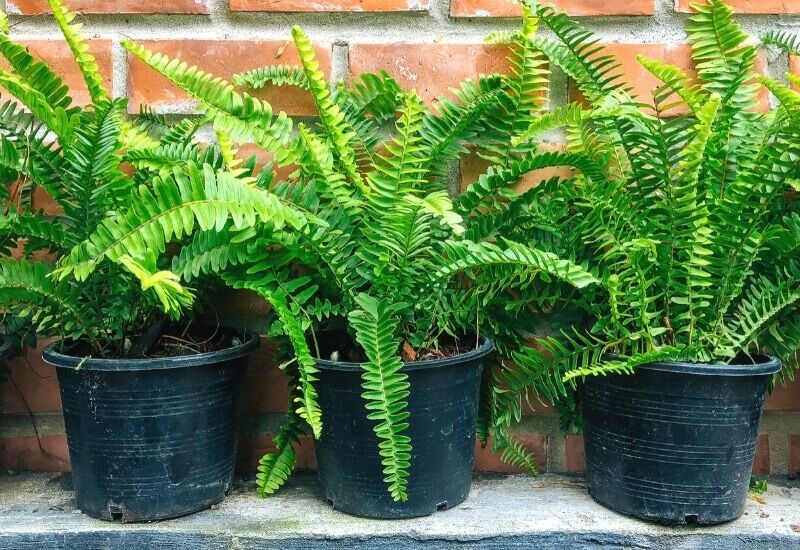
Typically found in warm and humid conditions like Florida, the Sword fern (also known as Boston fern) has vibrant bright green fonds which shoot out from the base of the plant.
As a tropical plant, the Sword fern prefers to live in bright indirect light with warm and humid conditions. Commonly seen as a hanging plant, they make a wonderful centrepiece for a north-facing window.
Water often with occasional fertilizer to keep the soil moist. If placing near a window, ensure it is tightly sealed before winter, as the Sword fern will not tolerate a cold draft.
Water: Water frequently, keeping the soil moist.
Light: Prefers bright, indirect light.
Description: Requires high humidity to thrive. Often grown as a hanging plant, ideal for north-facing window.
11. Snake Plant (Sansevieria Trifasciata)
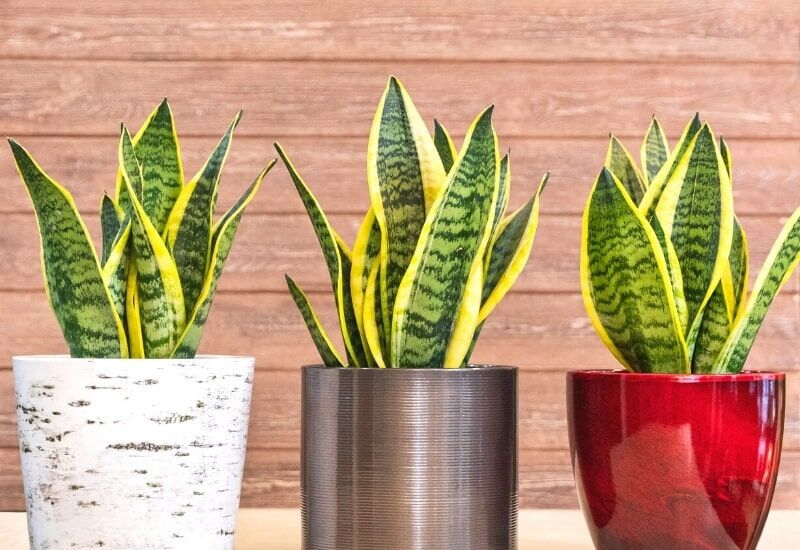
The snake plant is an interesting and playful looking plant with a high tolerance to neglect and a variety of light conditions.
These incredibly resilient jungle plants are adored for their tall sword-like leaves that seem to shoot out of the ground and their added bonus of being very efficient at cleaning the air.
Snake plants thrive in bright indirect light, but will also do fine in lower-light conditions. This makes them ideal for north-facing windows, although the speed of growth may be a little slower.
The snake plant is very sensitive to cold, so it is a good idea to move the plant away from the window in the winter. They also will not tolerate overwatering, so only water your snake plant once the soil is almost completely dry.
Water: Will not tolerate overwatering. Only water once soil is completely dry.
Light: Prefers bright, indirect light. Can tolerate lower-light conditions but the speed of growth will be slowed.
Description: Highly sensitive to colder temperatures. Toxic to pets.
12. Peace Lily (Spathiphyllum Wallisii)
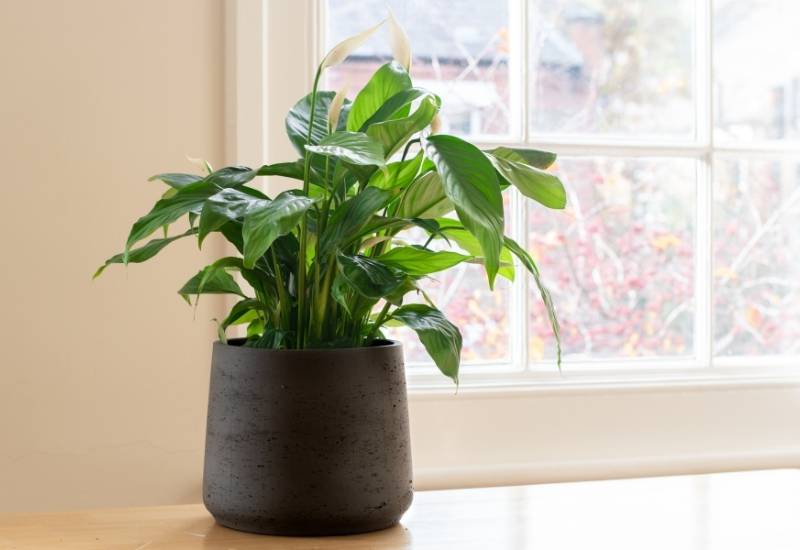
Peace lilies are one of the few plants who can produce flowers in lower light conditions. But don’t worry it is normal if yours only produces a few flowers, or none at all. These plants tend to grow slowly, but they are capable of producing flowers all year long with sufficient light.
A great communicator, the Peace lily will often tell you when its thirsty. You’ll sometimes see the whole plant dramatically wilt when the soil is too dry.
But not to worry, the Peace lily is tough and will spring back to normal within a few minutes of watering. Try to avoid this by keeping the soil moist. Peace Lilies are toxic to pets and humans.
Water: Water regularly, or when you notice the plant has wilted.
Light: Does well with indirect light, but may need brighter light to flower.
Description: Prefers average temperatures and humidity. Toxic to pets.
13. Cast Iron Plant (Aspidistra Elatior)
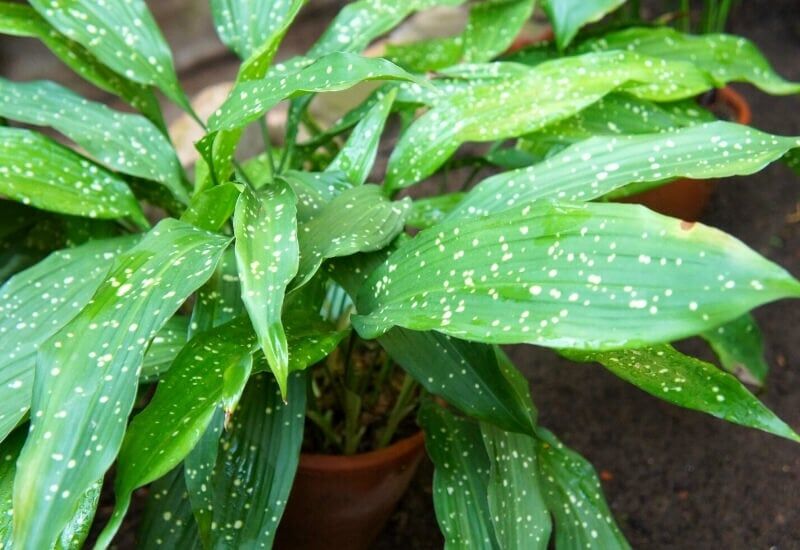
The cast iron plant has earned its common name because of its impressive tolerance to neglect. In fact, too much love and attention will actually be to the detriment of the plant. It prefers to be left alone, away from direct sunlight.
These plants grow slowly, but look great in large containers when mature. If you are hoping to fill a bigger space, you should buy a larger plant to begin with.
Pot in well-draining soil and allow the soil to completely dry between waterings. Yellowing leaves are an indication of overwatering.
Water: Water infrequently, allowing the soil to completely dry between waterings.
Light: Actually prefers to live in significant shade. Avoid any direct sunlight.
Description: Extremely durable plant who thrives on neglect.
14. Chinese Evergreen (Aglaonema Modestum)
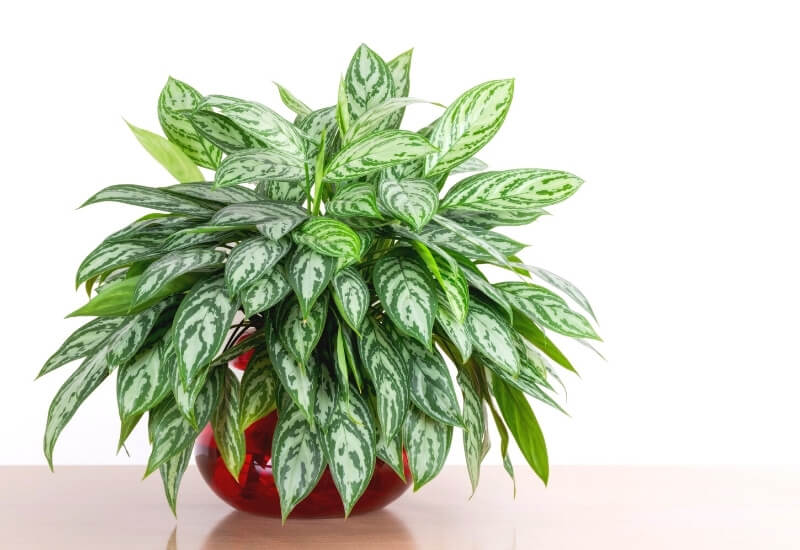
The Chinese evergreen stands out from other shade plants because of its beautiful fullness and marbled green, silver, and grey appearance. They can grow 1-3 feet tall and wide, making them great for a large container.
These plants can do well in low-light, but still need some direct light to thrive. A handy trick to tell where your Chinese evergreen plant will do best, is by looking at the colour of its leaves. The darker the green, the better your plant will do in shady conditions.
Intolerant to the cold, these plants will turn brown if exposed to temperatures below 60 degrees. Avoid this by moving the plant away from the window in the winter. The Chinese evergreen is also toxic to pets.
Water: Water regularly, keeping the soil moist.
Light: Can do well in low-light, but needs at least some direct light to thrive.
Description: Prefers a more humid environment. Intolerant to the cold.
15. Pinstripe Calathea (Calathea Ornata)

As a plant which is native to the rainforest floor, the Pinstripe calathea does best in humid, warm, and shady conditions. Known for their stunning dark green leaves with white stripes, these houseplants will be worth the extra care and attention they require.
The Pinstripe calathea is rather specific about its growing conditions. It requires the environment to be humid, with consistent watering, and just the right amount of indirect light.
Luckily this plant is able to express when its preferred conditions are not met before any harm is done, by curling the leaves as a signal that something is wrong. When positive conditions have been restored, the leaves will uncurl as a sign that the plant is happy.
Humidity can be supplemented by placing the plant in the bathroom, using a traditional humidifier, or placing a cup of water on top of a radiator near the plant.
Water: Water regularly, keeping the soil moist.
Light: Prefers a shady environment, away from any direct sunlight.
Description: A fairly picky plant with specific needs. Supplement humidity and be patient in finding ideal light conditions.
16. Parlor Palm (Chamaedorea Elegans)
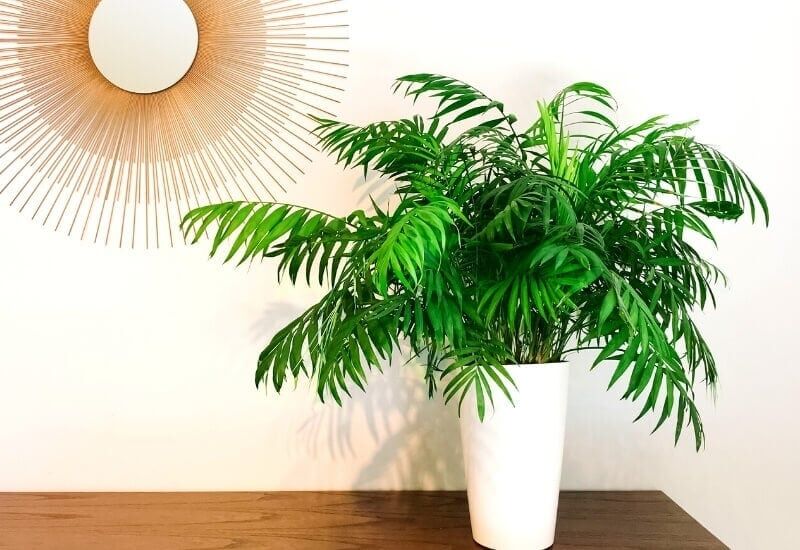
The Parlor palm is a versatile plant with soft leaves and thin stems, which can be grown either as a small windowsill plant or a large floor plant. They prefer indirect light and will do well in a north-facing window.
These plants are easy to over-water, so make sure to allow the soil to dry before watering again. If cared for properly, they can reach up to six feet tall. But be extra careful while repotting, because the Parlor palm has very fragile roots.
Water: Avoid overwatering by allowing the soil to dry before watering again.
Light: Thrives in indirect light.
Description: Can reach up tp six feet tall. Be careful not to damage fragile roots when repotting.
17. Nerve Plant (Fittonia)
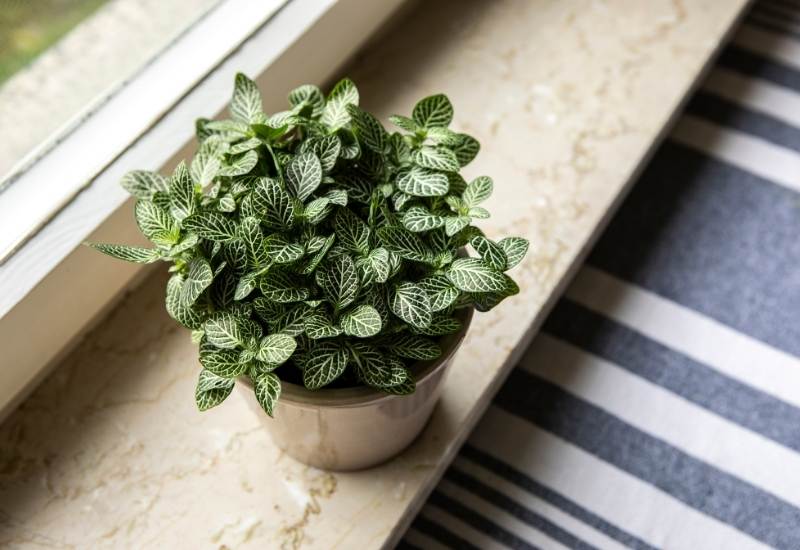
There are many different types of Fittonia plants. Their common name as the Nerve plant comes from the beautiful colored veins which paint their dark green leaves. These veins can be silver, pink, green, or white, giving the plant its distinctive appearance.
These plants are a little more temperamental than most other low-light plants.
Great for bathrooms, they grow best in hot and humid rooms with filtered light or partial shade. Another option is the grow your nerve plant in a closed terrarium, where it will thrive in the warm, humid conditions.
Although these plants require frequent water, a delicate balance must be maintained to avoid root rot. Pot in well-draining soil and water regularly.
It would be beneficial to supplement humidity with regular hot showers if placed in the bathroom, a humidifier, or cup of water placed on top of a radiator near the plant.
Water: Requires regular watering, but be careful to avoid root rot.
Light: Prefers indirect light or partial shade.
Description: Best grown in a terrarium for its high humidity and temperature requirements.
18. Painted-Leaf Begonia (Begonia Rex)
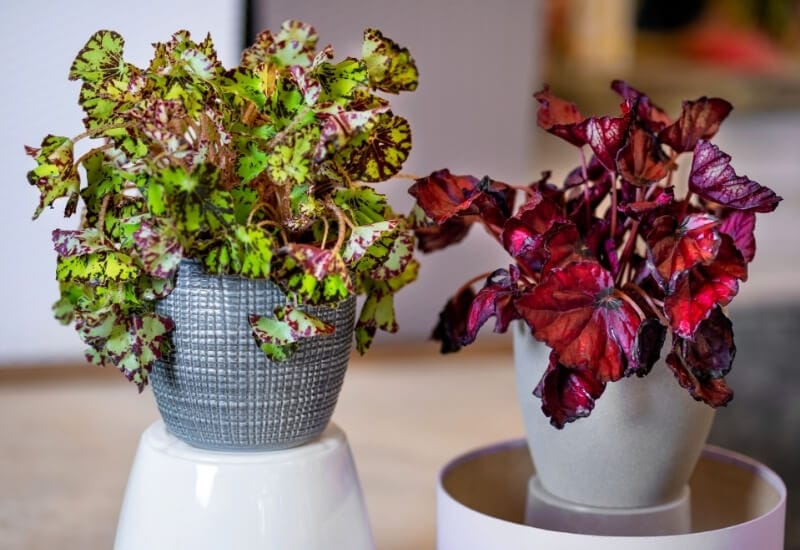
Begonias are often grown for either their flowers, or their lovely colorful leaves. Although the flowering begonias need a good amount of sunlight, the Rex begonia actually prefers to be in a shady location.
There are many different variations of the Rex begonia to choose from, each with their own unique set of colors and leaf patterns.
Easy to care for and quite hardy, Rex begonias would be a good choice for a north-facing window. Pot in well-draining soil and water regularly, allowing the soil to dry between waterings.
Water: Water regularly, allowing the soil to dry between waterings.
Light: Prefers to be in a shady location. Great for low-light rooms.
Description: Easy to care for. Does well with warm and moderately humid conditions.
19. Bromeliads (Bromeliacea)
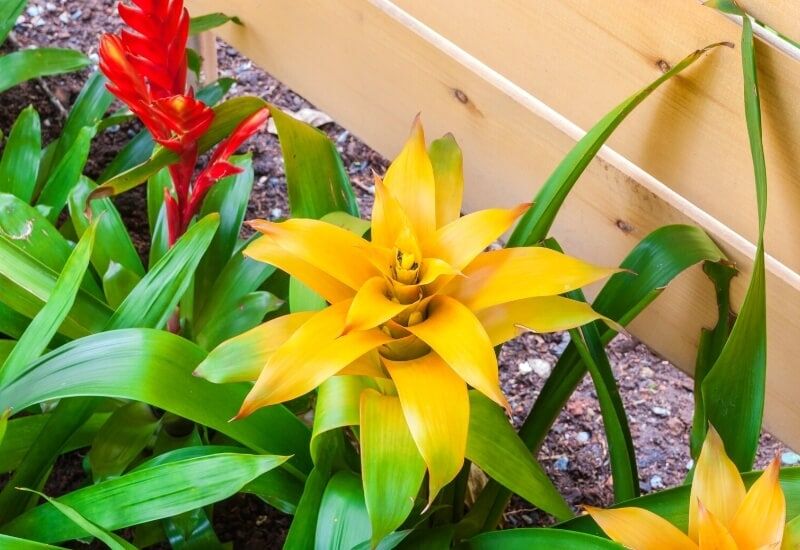
Related to the pineapple, there are over three thousand different species of bromeliad plants on planet Earth. Almost all of which, thrive in low-light conditions.
There are many different colors, types of foliage, and patterns available. However, for a north-facing window you should choose a variety which comes from the rainforest and has a darker color.
Bromeliaceae Guzmania and Bromeliaceae Aechmea would both be very happy in a north-facing window.
Although these plants are easy to care for, they are unfortunately short-lived. This means if you want to keep the plant alive, you must propagate the “pups” when they appear. Plant in well-draining soil and water regularly.
Water: Water regularly, allowing soil to dry between waterings.
Light: Thrives in low-light conditions.
Description: Choose a darker coloured plant for north-facing windows. This plant is short lived, meaning you must propagate pups to continue growing.
20. Moth Orchid (Phalaenopsis)
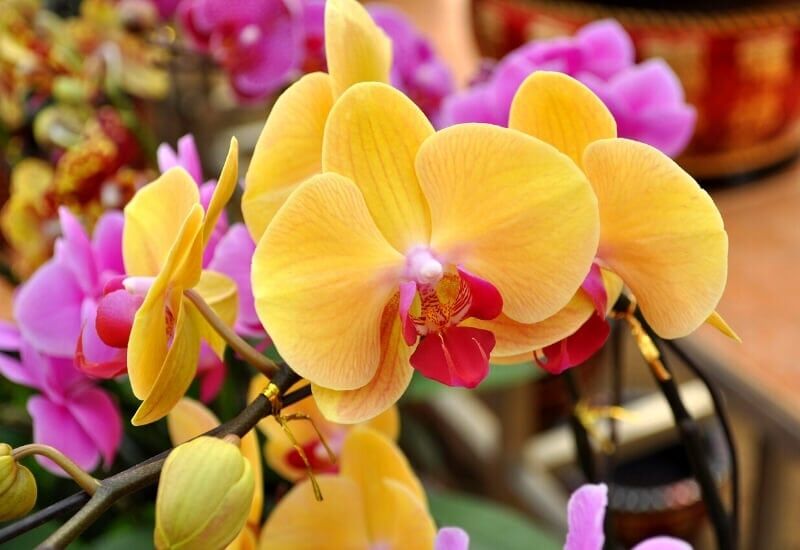
Moth orchids will be the star of your north-facing window, because they are one of the few flowering plants who are actually able to thrive in low-light conditions. They do best with bright, indirect sunlight.
In the wild, moth orchids grow as epiphytes. This means they require a host plant to grow off of, usually being the surface of a rainforest tree.
To mimic these conditions, instead of regular potting soil you should consider an alternative material such as bark, moss, peat moss, or small rocks for potting your Moth orchid.
With delicate, long-lasting blooms that can last for months at a time, these plants are a beautiful and elegant addition to any home.
They are fairly easy to care for, preferring to be watered infrequently and have average temperatures. Root rot can be an issue, so check the potting media is dry before watering again.
Water: Water regularly, but allow to growing medium to dry between waterings to avoid root rot.
Light: Thrives in bright, indirect light. Perfect for a north-facing windowsill.
Description: Pot in alternative growing medium such as bark or or small rocks. Prefers average temperatures and humidity.





